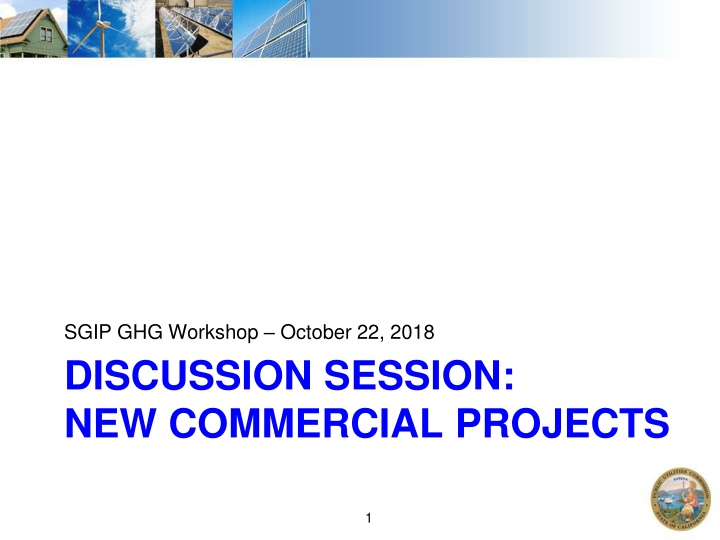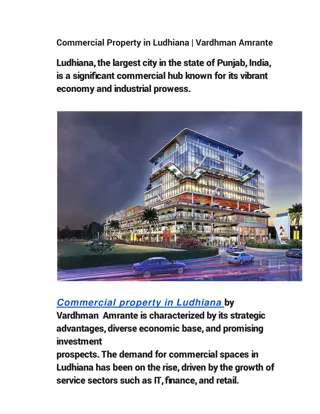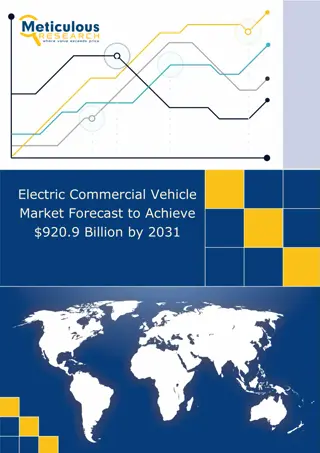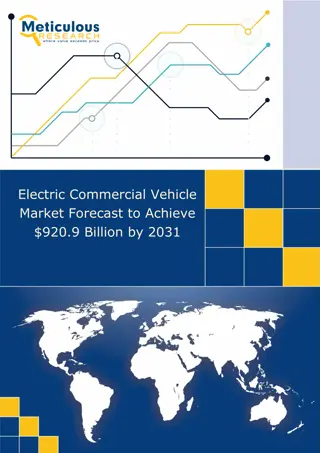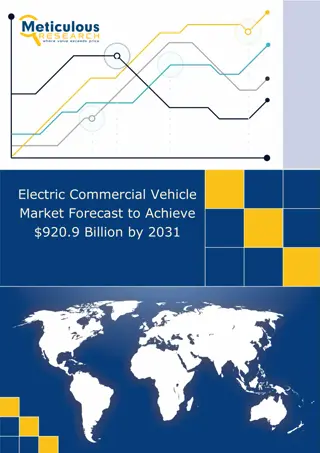New Commercial Projects Discussion
This discussion session on new commercial projects addresses proposals to reduce greenhouse gas emissions. Topics include evaluating options for new rules, staff proposals, and questions on achieving GHG reductions while meeting program goals.
Uploaded on Mar 09, 2025 | 0 Views
Download Presentation

Please find below an Image/Link to download the presentation.
The content on the website is provided AS IS for your information and personal use only. It may not be sold, licensed, or shared on other websites without obtaining consent from the author.If you encounter any issues during the download, it is possible that the publisher has removed the file from their server.
You are allowed to download the files provided on this website for personal or commercial use, subject to the condition that they are used lawfully. All files are the property of their respective owners.
The content on the website is provided AS IS for your information and personal use only. It may not be sold, licensed, or shared on other websites without obtaining consent from the author.
E N D
Presentation Transcript
SGIP GHG Workshop October 22, 2018 DISCUSSION SESSION: NEW COMMERCIAL PROJECTS 1
Discussion Session: New Commercial Projects Discussion Session Introduction Discussion questions Designed to support Commission s evaluation of options for new GHG rules Questions do not address all issues raised in party comments Format Overview of staff proposal Discussion questions and answers Line up at mike Identify yourself and who you represent Comment only on the project category and question at hand Comments from Webex will be read aloud by staff Other questions from stakeholders (time permitting) 2
Discussion Session: New Commercial Projects Staff Proposal for New Commercial Projects Eliminate RTE requirement Use a 40% upfront payment / 60% performance- based incentive structure for all new commercial projects Reduce performance-based payments in proportion to GHGs: Project annual GHG impact PBI payment reduced by: 0% 25% 50% 100% Reduce GHGs by more than 25 kg CO2/kWh Reduce GHGs by 0-25 kg CO2/kWh Increase GHGs by 0.1-25 kg CO2/kWh Increase GHGs by > 25 kg CO2/kWh 3
Discussion Session: New Commercial Projects Discussion Questions Regarding staff s proposal for new commercial projects to reduce GHGs by at least 25 kg/kWh to recoup full payment 1. SGIP projects are required by statute to reduce GHGs, not achieve net zero GHGs. In comments on the staff proposal, several parties note that SGIP also has other program goals, including market transformation, peak demand reduction, and providing grid services. If the Commission were to require each commercial SGIP project to demonstrate GHG reductions as a condition for PBI payment, what impact would that have on the other program goals? Please be specific and provide concrete examples where applicable. 4
Discussion Session: New Commercial Projects Discussion Questions Regarding staff s proposal for new commercial projects to reduce GHGs by at least 25 kg/kWh to recoup full payment 2. Citing Working Group (WG) and OSESMO modeling results, PG&E questions in its comments whether projects could feasibly achieve 25 kg/kWh of GHG reductions while optimizing for customer bill reductions, and instead proposed a 10 kg/kWh reduction threshold to recoup full payment. a. Do stakeholders agree or disagree with PG&E's characterization of the modeling results that 25 kg/kWh of GHG reductions is infeasible without increasing customer bills? Why or why not? b. Do stakeholders agree or disagree with PG&E's characterization of the modeling results that 10 kg/kWh of GHG reductions is feasible without increasing customer bills? Why or why not? 5
Discussion Session: New Commercial Projects Discussion Questions Regarding staff s proposal for new commercial projects to reduce GHGs by at least 25 kg/kWh to recoup full payment In comments, CSE opposes reducing PBI payments for projects that reduce GHGs less than 25 kg/kWh, stating projects don't yet have experience responding to a GHG signal and there are many unknowns at both the host customer site and system-wide level that could impact any given project's ability to reduce GHGs. 3. a. What are the unknowns at the host customer site and system-wide level that could cause a project to increase GHGs? b. Do developers share CSE's concern that they may not be able to achieve reductions for a given project using the GHG signal? Why or why not? 6
Discussion Session: New Commercial Projects Discussion Questions Regarding the method for calculating penalties exceedance bands vs. $/ton: In comments, CALSSA, CESA, Tesla, and Stem highlight several drawbacks of the exceedance band approach, including that it sets penalties out of proportion with the environmental damage caused, penalizes small and large emitting projects roughly the same, and removes incentives for projects that can't reach the next exceedance band to reduce at all. Multiple parties instead proposed using a $/ton approach. Momentarily setting aside the magnitude of the penalty, do stakeholders favor an exceedance band approach or a $/ton approach? Why or why not? 4. 7
Discussion Session: New Commercial Projects Discussion Questions Regarding the method for calculating penalties exceedance bands vs. $/ton: In comments, CALSSA et al. proposes to base the $/ton penalty on either a market price (~$15/ton), the social cost of carbon established in R.14-20-003 ($69.50/ton), or the IRP price adopted in D.18-02-018 ($150/ton). At the highest price, a 100 kWh project emitting 3 metric tons would have its $3,600 annual PBI payment deducted by $450, or 12%, compared to 100% per the staff proposal. 5. a. SB 700 requires the Commission to "adopt requirements for energy storage systems to ensure that eligible energy storage systems reduce the emissions of greenhouse gases." Would a $150/ton penalty provide sufficient incentive to ensure projects reduce GHGs? b. Are there other $/ton values the Commission should consider? 8
Discussion Session: New Commercial Projects Discussion Questions Regarding staff s proposal to adopt a 40/60 PBI structure for all commercial projects: 6. Small projects: The 2017 SGIP Storage Impact Evaluation found that small commercial projects (< 30 kW) have resulted in the largest increase in GHGs per kWh. In its comments, Stem argues that withholding 60% of incentives, coupled with the potential for PBI payment reductions and the additional cost of revenue grade metering, could make financing small systems all but impossible, and proposes a 70/30 split instead. a. What evidence can Stem or others provide to support the statement that financing smaller projects will be "all but impossible" under a 40/60, 50/50, or 60/40 PBI structure? b. What is the cost difference between revenue grade metering and non-revenue grade metering on a total $ basis and as a percentage of total system cost? What are the tradeoffs of requiring one versus the other? 9
Discussion Session: New Commercial Projects Discussion Questions Regarding staff s proposal to adopt a 40/60 PBI structure for all commercial projects: 7. Large projects: In comments, Tesla estimates that reducing the PBI split from 50/50 to 40/60 will reduce the total net present value of a $0.35/kWh SGIP incentive by 11%, assuming a 7% discount rate (opening comments, p. 18). In comments, CALSSA argues that reducing upfront incentives may make storage project development too difficult given other headwinds facing the storage industry, such as lengthy and uncertain interconnection and local permitting processes and delays in processing SGIP incentive claims, and PG&E argues that reducing upfront incentives may further exacerbate the current stagnation in SGIP s commercial budget. a. Do stakeholders agree with Tesla s estimate? b. What impact would reducing the upfront payment from 50% to 40% have on the program? To what extent will it impact customer participation? To what extent will it increase compliance with program rules? 10
SGIP GHG Workshop October 22, 2018 NEW COMMERCIAL PROJECTS Other questions/comments from stakeholders 11
SGIP GHG Workshop October 22, 2018 LUNCH 12
SGIP GHG Workshop October 22, 2018 DISCUSSION SESSION: NEW RESIDENTIAL PROJECTS 13
Discussion Session: New Residential Projects Staff Proposal for New Residential Projects Eliminate RTE requirement Require all new residential projects to: Be on a TOU rate with peak starting at 4pm or later Pair with (and charge at least 75% from) solar Have a single cycle RTE of at least 85% Developers with residential fleets that increase GHGs would be suspended 90-360 days 14
Discussion Session: New Residential Projects Discussion Questions Regarding fleet verification and enforcement approach versus a deemed compliance approach for new residential projects: 8. In comments, Tesla s and CESA s main rationales for supporting a pure deemed compliance approach are the WG modeling results showing that projects that meet certain criteria are 83% likely to reduce GHGs. The staff proposal acknowledged potential problems with the modeling methodology,such as different assumptions across modelers and the fact that not all modelers ran all scenarios. Considering this, how much weight should the Commission give the modeling findings? 15
Discussion Session: New Residential Projects Discussion Questions Regarding fleet verification and enforcement approach versus a deemed compliance approach for new residential projects: 9. In comments, CSE, Tesla, CALSSA and CESA oppose fleet verification and enforcement in favor of a pure "deemed compliant" approach, in part because they assert the administrative burden would outweigh the small avoided GHG impact of residential projects. a. Question for PAs: What would the estimated annual administrative cost be for PAs to implement fleet verification and enforcement for residential fleets? b. Question for PAs: How long would it take to implement staff s proposal for residential fleet verification and enforcement (i.e. how much lead time before new rules could go into effect)? c. Question for Residential Developers: What would the estimated annual administrative cost be for developers to submit electric charge and discharge data for their residential projects to Itron twice a year? d. Residential projects are growing as a percentage of total program rebated capacity. Is this trend likely to continue, and for how long? Do stakeholders expect residential projects to make up a significant portion of program rebated capacity in the future? 16
Discussion Session: New Residential Projects Discussion Questions Regarding staff s proposal to require new residential projects to pair with solar, based on WG modeling findings that pairing with solar increases the likelihood projects will reduce GHGs from 67% to 83%: 10. In comments, Tesla, CESA, PG&E, and SDG&E oppose requiring new residential projects to pair with solar, arguing that stand-alone storage is equally capable as paired storage of achieving GHG savings by confining charging to PV-generating hours (akin to solar self- consumption mode ), and that some customers may be unable to deploy solar for various reasons (e.g. affordability, shaded roof). a. The WG modeling found that adopting charging time constraints did not lead to significant GHG reductions (WG Report, p. 57). Should the Commission adopt charging time constraints in lieu of a requirement to pair with solar, despite WG modeling results indicating they may not be effective? Why or why not? If yes, what time constraints do stakeholders recommend? 17
Discussion Session: New Residential Projects Discussion Questions Regarding staff s proposal to require new residential projects to pair with solar, based on WG modeling findings that pairing with solar increases the likelihood projects will reduce GHGs from 67% to 83%: b. Are there measures other than charging time constraints or requiring storage to pair with solar that the Commission should consider to encourage residential storage to charge during solar generating hours? c. Of the solutions modeled by the WG, the use of a GHG emissions signal was significantly more effective in achieving GHG reductions than the addition of constraints on storage charging and discharging times or the requirement to enroll on a new TOU rate, neither of which capture often significant intra-period variations in grid emissions (WG Report, p. 146). In lieu of upfront requirements to pair with solar or confine charging to certain hours, should the Commission simply make the GHG signal available, require residential fleets to reduce GHGs, and allow them to find the best way to do so? 18
Discussion Session: New Residential Projects Discussion Questions Regarding penalties for residential fleet GHG increases program suspension vs. financial penalty: 11. In comments, Tesla argues that the prospect of program suspension for developers with GHG-increasing fleets would make them highly reluctant to market SGIP to customers. Instead, they propose that PAs levy financial penalties on developers with GHG-increasing fleets, with the option of program suspension if the developer fails to pay the fee. a. Would a financial penalty provide enough incentive to ensure developer fleets reduce GHGs? b. Which would pose a greater administrative burden on PAs and residential developers, financial penalties or program suspensions? c. Are there other tradeoffs of using financial penalties versus program suspensions that the Commission should consider? 19
SGIP GHG Workshop October 22, 2018 NEW RESIDENTIAL PROJECTS Other questions/comments from stakeholders 20
SGIP GHG Workshop October 22, 2018 DISCUSSION SESSION: LEGACY PROJECTS 21
Discussion Session: Legacy Projects Staff Proposal for Legacy Projects Two compliance pathways: 1. Remain under existing RTE rules 2. Opt in to GHG reduction pathway (RTE req. is waived, annual cycling requirement reduced from 260 to 130) Each pathway would be subject to verification and enforcement at the developer fleet level Developers with residential fleets that don t meet RTE or GHG requirements would be suspended (90-360 days for GHG fleet, 180-360 days for RTE fleet) 22
Discussion Session: Legacy Projects Discussion Questions Regarding staff s proposal for the adoption of retroactive fleet enforcement mechanisms for legacy projects electing the RTE pathway: 12. In comments, CESA recommends the Commission recognize the trail-blazing nature of legacy systems, the evolution and learning of industry participants, the relatively small amount of GHG emissions reductions and involved legacy incentives at stake, and generally exempt legacy systems from new requirements. Do other stakeholders agree that a lighter enforcement approach for legacy systems is warranted? Why or why not? 23
Discussion Session: Legacy Projects Discussion Questions Regarding staff s proposal for the adoption of retroactive fleet enforcement mechanisms for legacy projects electing the RTE pathway: 13. In comments, CSE argues that legacy RTE fleets should not be subjected to retroactive rule changes in the form of fleet verification and enforcement and automatic program suspensions, but should instead remain subject to existing SGIP handbook infraction language at the time of their application submission. a. Would relying on existing handbook language, which grants PAs broad discretion to enforce rules but provides little structure or process for doing so, increase or decrease the administrative burden on PAs to enforce compliance with RTE rules compared to the fleet verification and enforcement regime proposed by staff? b. If the Commission allows legacy systems to remain under existing RTE rules and enforcement mechanisms, what incentive would legacy systems have to opt in to the GHG pathway? Are there other, administratively-simple carrots or sticks the Commission should consider adopting to encourage legacy systems to select the GHG pathway? 24
SGIP GHG Workshop October 22, 2018 LEGACY PROJECTS Other questions/comments from stakeholders 25
SGIP GHG Workshop October 22, 2018 DISCUSSION SESSION: OTHER ITEMS 26
SGIP GHG Workshop October 22, 2018 WRAP UP/NEXT STEPS Mary Claire Evans (maryclaire.evans@cpuc.ca.gov) Asal Esfahani (asal.esfahani@cpuc.ca.gov) Workshop materials available at: http://cpuc.ca.gov/General.aspx?id=5935 27
